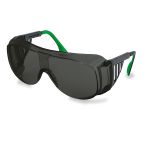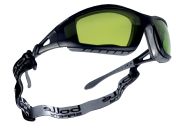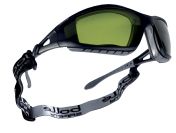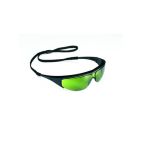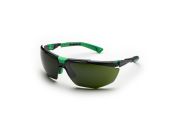Welding Glasses
Welding glasses are important pieces of safety eyewear that protect your eyes from arc flash burns, also known as "welder's flash" or "arc eye", when using welding equipment. Ultraviolet radiation is generated by electric welding arcs and can damage your eyes, similar to sunburn on the skin, and welding glasses are important pieces of PPE (Personal Protection Equipment) for welders and similar applications.
Why should I wear them?
Most arc flash accidents happen to workers within the area of the welding rather than the workers involved directly in the welding process, but welding glasses should be worn by everyone in the vicinity. Modern welding safety glasses absorb up to 99% of the damaging UV radiation as well as protecting the eyes from any welding sparks or debris. Welding glasses have strong, wrap-around polycarbonate lenses that follow the contour of the face, so that the eyes are also protected from the side. Always use welding glasses that adhere to industry recognised standards.
Safety Standards include:
EN 166:2001, EN 169, EN 379EN 171, EN 171, EN 172, EN 1836, EN 175:1997, EN 279:2003.
When choosing welding glasses, ensure that you choose the best available protection for your eyes. Always refer to the industry standards produced by the Health and Safety Executive or the British Standards Institute (BSI). Remember that you do not have to be welding to damage your eyes, just being in the area of a welding process can cause eye damage.
Lens Shade:
The lens shade number indicates the intensity of the darkness provided by the lenses to protect your eyes. The higher the shade protection number, the darker the lens. The darker lenses filter out harmful UV (ultraviolet) and IR (infrared) waves. Shade numbers are a guide used by welders to select the most comfortable and clear lens for specific operations. Shade numbers generally range from 2 to 14.
Lens Material:
Polycarbonate is typically used for welding glasses lenses due to its strength, toughness and light weight. A standard for eye protection.
Common added protection features
- Anti-mist coating
- UV Protection
- Frame material – Polycarbonate for flexibility, strength
- Anti-scratch
Frame/Lens Markings:
Frames normally have a mechanical strength marked on the frame that indicates the lens protection, as follows:
- S = increased robustness
- F = high-speed particle, low energy impact of any type
- B = high-speed particle. Medium energy impact
- A = high-speed particle, high energy impact
14 Products showing for Welding Glasses
Popular Searches
Related links
- uvex Scratch Resistant Welding Glasses
- uvex Flip Up Anti-Mist Welding mask glasses, for Direct Protection
- Bolle Safety TRACKER Welding Glasses
- Safety Glasses
- Honeywell Safety MILLENNIA Welding Glasses
- Bolle Safety SLAM Welding Glasses
- Bolle Safety SQUW Scratch Resistant Welding Glasses
- Bolle Welding Glasses


